Melkote — Where time stands still — Yoga Narasimha Hill Temple — Ramanuja — Shri Vaishnava
By Tarini Carr
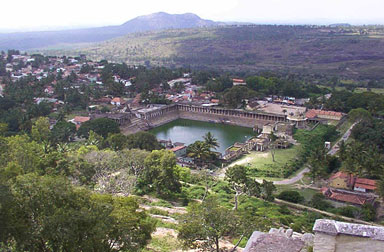
It was a hot and sunny day (much like every other day in India, except in the monsoon season) and we were on our way to Melkote. It would appear I was wrong, for there is indeed a worse road in Karnataka than the one that led to Somnathpur, and this one went to the town of Melkote, and was unfortunately twice as long. However, no matter how bad the road is, there is always something interesting to see anywhere one goes in India. We were stopped at a train track, and on the other side was an ox cart waiting amidst the automobiles to cross. It was an interesting juxtaposition of era's. A modern train going by, and an ageless painted oxcart. If it weren't for the trousers the cart driver was wearing, he and his oxen could have been from a time a thousand years ago. That is one of the striking aspects of India, wherever you 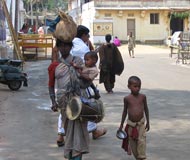
![]() go, there is this mix of the old, the new, the unchanged, and the downright odd. Such as a boy, squatting by the side of the road, brushing his teeth in water so muddy it seemed to negate the point of the exercise. Or a lady wearing a sari so electrically yellow, I swear one needed sunglasses to look at her. Or how people like to park their bicycles either on, or right in the middle of the smaller roads. Either they wish an untimely destruction of their bike, or they just simply see it as good parking spot I'm not certain. There is certainly a different etiquette over here regarding pedestrians. All the time, one sees a group of 4 or more girls or boys walking in line with one another taking up part of the road. And when a car comes, they don't budge, or fall back in a line, they continue on walking. There is an order to the chaos that is first observed here, as far as driving goes. And there isn't as many accidents as one may reasonably suppose.
go, there is this mix of the old, the new, the unchanged, and the downright odd. Such as a boy, squatting by the side of the road, brushing his teeth in water so muddy it seemed to negate the point of the exercise. Or a lady wearing a sari so electrically yellow, I swear one needed sunglasses to look at her. Or how people like to park their bicycles either on, or right in the middle of the smaller roads. Either they wish an untimely destruction of their bike, or they just simply see it as good parking spot I'm not certain. There is certainly a different etiquette over here regarding pedestrians. All the time, one sees a group of 4 or more girls or boys walking in line with one another taking up part of the road. And when a car comes, they don't budge, or fall back in a line, they continue on walking. There is an order to the chaos that is first observed here, as far as driving goes. And there isn't as many accidents as one may reasonably suppose.
Today, our trip was on to Melkote, a famous pilgrimage spot in Karnataka. A friend from America was visiting, his first time ever to India, so he and a couple of my young Indian friends were along for the ride. As we drove farther and farther away from Mysore, the landscape changed, from lush green rice and millet fields and coconut groves, to drier open plains and strange rocky formations, that looked like giants had a game throwing around huge boulders and left them where they fell. The mountains, as I think they could be called, were just that, giant piles of boulders and a little scrub. There was a strange beauty in the barren landscape, of dust and dry grass and rocks. A few kilometers from our destination I saw a big hill, and upon it was the temple of Yoga Narasimha, a place that is mentioned even in the Puranas of Vedic Literature, (these date back to a time of a couple thousand years ago). Like many temples in India, the temple of Yoga Narasimha was built on a hill. This was and is a common practice, hills are considered sacred spots, and symbolically to put a temple upon a hill is to put it above you, it is something to revere being closer to the heavens. Melkote has two distinct temples. The Tirunarayana temple at the foothills and the hill temple to Yoga Narasimha The Tirunarayana temple worships a deity of Lord Visnu, and the temple of Yoga Narasimha houses a deity to Narasimha, who is the half-man half-lion incarnation of Lord Visnu.
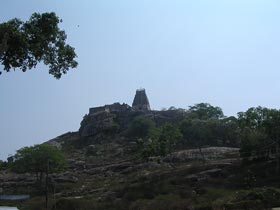
After driving up a few narrow winding streets we reached the parking place at the foot of the hill. Leading up to the temple were stone steps, some carved right into the hillside, and others put there, but all worn by the feet of innumerable pilgrims making their way up to the temple. The air was perfumed with the scent of plumeria, there were dozens of trees growing all along the walkways. It was an intoxicating smell.

![]() Lining the steps on either side were many beggars and sadhu's alike, some of them quite colorful characters with turbans, big bead necklaces and matted hair, but all with the markings of tilak upon their foreheads. In different forms, all relegions in India have a marking the devotees put upon their forehead that signifies the faith they follow. The sri vaisnava tilak is large and striking, covering most of the forehead. As we made our way up, I was curious why we were not being badgered by the beggars there. They were not being their usual vociferous selves, in fact they were utterly silent as we passed by. I discovered later they all start up while on your way down. But they weren't rude as many of the beggars I have encountered are, some of which will follow you for several blocks and stand outside the shop your in until you come out again. The people here just pleasantly talked to you in a language I didn't understand, and some called out 'madam, madam', however it is hard because if you give one person a coin you won;t have any peace after that.
Lining the steps on either side were many beggars and sadhu's alike, some of them quite colorful characters with turbans, big bead necklaces and matted hair, but all with the markings of tilak upon their foreheads. In different forms, all relegions in India have a marking the devotees put upon their forehead that signifies the faith they follow. The sri vaisnava tilak is large and striking, covering most of the forehead. As we made our way up, I was curious why we were not being badgered by the beggars there. They were not being their usual vociferous selves, in fact they were utterly silent as we passed by. I discovered later they all start up while on your way down. But they weren't rude as many of the beggars I have encountered are, some of which will follow you for several blocks and stand outside the shop your in until you come out again. The people here just pleasantly talked to you in a language I didn't understand, and some called out 'madam, madam', however it is hard because if you give one person a coin you won;t have any peace after that.
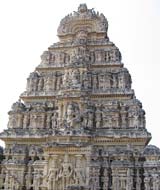
![]() The temple itself was very beautiful —you entered the complex through two huge bronze doors, made of squares set in different designs. South Indian style temples always have gopurams, vertical ascending roofs that narrow to the top, and covered every inch of the way in carvings of demigods, animals, and various stories from the Vedic literatures. Going through another set of huge doors brought us into the temple. It was dark and cool in there. I immediately sensed the sacredness of the place. Winding through corridors
The temple itself was very beautiful —you entered the complex through two huge bronze doors, made of squares set in different designs. South Indian style temples always have gopurams, vertical ascending roofs that narrow to the top, and covered every inch of the way in carvings of demigods, animals, and various stories from the Vedic literatures. Going through another set of huge doors brought us into the temple. It was dark and cool in there. I immediately sensed the sacredness of the place. Winding through corridors and other rooms, supported by large stone pillars, hewn out of single chunks of stone, it was a wonder of construction. Everything was made of stone, that had to be hauled up this hill, carved, and somehow moved into place. Melkote didn't have the magnificence of design, or the amount of sculpture that the temple at Somnathpur had, but it had a powerful architecture. The stone walls were cool to the touch, and as I brushed my hand along them, a strange feeling came over me, as it they were alive and watching me. We weren't the only ones there, in fact, we were only a few out of many. Melkote is a very popular place of pilgrimage. I noticed many people walking around with shaved heads, anywhere from 2-80 yrs old. I discovered that it is a custom to shave ones head when they come here, and to take a bath in the large stone tank, or ghat that is below in the town.
and other rooms, supported by large stone pillars, hewn out of single chunks of stone, it was a wonder of construction. Everything was made of stone, that had to be hauled up this hill, carved, and somehow moved into place. Melkote didn't have the magnificence of design, or the amount of sculpture that the temple at Somnathpur had, but it had a powerful architecture. The stone walls were cool to the touch, and as I brushed my hand along them, a strange feeling came over me, as it they were alive and watching me. We weren't the only ones there, in fact, we were only a few out of many. Melkote is a very popular place of pilgrimage. I noticed many people walking around with shaved heads, anywhere from 2-80 yrs old. I discovered that it is a custom to shave ones head when they come here, and to take a bath in the large stone tank, or ghat that is below in the town.
Worship of the deity is carried out every day, as it has been for the last 900 years here. The exact establishment of the hill temple at Melkote is not known, the present temple being built upon the ruins of an old one, in the 12th century by Ramanujacarya, a saint who is still revered and followed today.
The temple is surrounded by a walkway, which is walled in because the hill drops right down. There was a magnificent view from the wall all across the scrubby plains and far off into other districts. Many other people were out enjoying the view, including a very charming little baby who had just undergone the ritual head shaving.


After walking around the temple for some time, we all started down again and headed into the town to visit the temple of Tiru Narayana.

![]() The lower town temple was a rather large complex, surrounded by an open veranda that was covered by many pilgrims sleeping, eating their lunches, or simply stopping for a moment. There were lions heads that faced the four cardinal directions. Inside, in the cloister area there were many ornately carved pillars, beautifully done. I walked around them, marveling at the artists who created these elaborate and lovely pieces of art. Mostly they detailed scenes from the epics of Vedic literature, the Mahabharata, The Ramayana, and other historic pastimes.
The lower town temple was a rather large complex, surrounded by an open veranda that was covered by many pilgrims sleeping, eating their lunches, or simply stopping for a moment. There were lions heads that faced the four cardinal directions. Inside, in the cloister area there were many ornately carved pillars, beautifully done. I walked around them, marveling at the artists who created these elaborate and lovely pieces of art. Mostly they detailed scenes from the epics of Vedic literature, the Mahabharata, The Ramayana, and other historic pastimes.
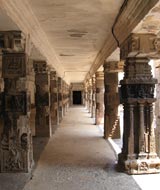
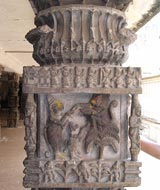
While I was standing and observing the goings on an old Tamil woman (Tamil Nadu is the state to the west of Karnataka) came up to me and spoke some words and touched my cheek. She smiled benevolently and looked so happy and peaceful, I smiled back at her, not knowing what to say, but I folded my hands in a sign of appreciation. I asked one of the Indian boys with me what she had said. Not being so familiar with the language of Tamil, they could only catch some of it, but said she gave me a blessing to live a long healthy life, and to visit other holy places. I was very struck by that, she had such an amazing aura of being completely at peace with the world.
The deity here is taken out during March-April and carried around in a festival procession. The carts are painted brightly and decorated with many flowers. A special aspect of these forays is the crowns (one of them is made of diamonds!) and jewels the deity is decorated with, these used to belong to the former Maharaja's of Mysore. Through the ages Melkote has received the patronage of many of the Maharajas of Mysore as well as the Tipu Sultan. When the procession is coming everyone gathers around. The kind of excitement that would go into seeing a celebrity here goes towards trying to get a glimpse of the gods!
After visiting the town temple and getting the traditional 'kumkum' or colored powder upon our foreheads (this is offered to the deity and then visitors place some upon their forehead) we then all tramped off to the ghat, or water tank were many people were busy talking a holy bath. The whole of the ghat was build down into the ground and all around it steps led down. Like the temple in the town an open veranda surrounded the whole area. Many people were taking naps here, or just sitting in groups. Like at the other temples, there were beautiful, carved pillars that held up the roof of the verandas. I didn't take a bath (having neglected to bring a change of clothes), but I sat and watched the many others doing so. Bathing in public in India is rather unlike bathing anywhere in the west. Ladies do not wear bathing suits, but instead go in their sari or dress. And you don't see people wildly jumping in the water or splashing around. It's a rather calm and ritualized process. But then again, they are not swimming for leisure, but for a ritual purification.
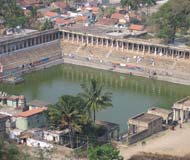

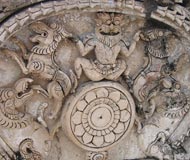
India is a very colorful country but Melkote seemed especially vivid to me. The shops were packed with electrically hued goods, there were piles of flowers and flower garlands for sale, all in shades of yellow, pink, purple, and white. The people seemed to be dressed more brightly and a mood of happiness and peace pervaded the air. I heard about an interesting custom here, a pilgrim can stay upon anyone's porch for one night, with no charge, and even be given breakfast as well.
On the way back home, just outside the townthere is a hill made of rock with a temple carved into its face. We stopped there and made the short hike through the fields up to it. The hill is literally made of solid rock. And the temple, albeit small, was hewn right into it. We stopped here for some minutes, and then one of the boys in a sudden fit of adventure started to climb up the rock face. And one by one we all followed. It was not very steep, and there being many handholds it was not too difficult to ascend. It was a lot of fun! There was a lovely view from the top of this giant rock, we could see in all directions. But, it was like standing on top of a skillet. The sun was directly overhead, and the rocks were searing hot, so we did not stay long. However getting down was slightly more difficult than it had been to get up, and there were one or two hairy moments. But everyone got down fine, and we continued on our way.
This temple town is also known for its Academy of Sanskrit Research. This was established in 1853 and has since then been a famous center of learning, considered unique in that its retained so much of its traditional character over the centuries. Historical studies have shown that there has been very little change in the town planning, the type and character of the houses and the cultural practice. However, one doesn't need to read a report to realize this, a visitor can see how it is truly is a town where India's rich cultural tradition is very much alive, and unchanged.

